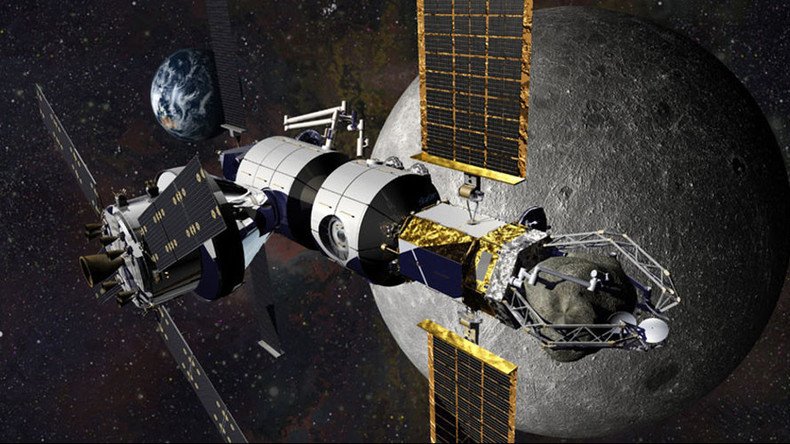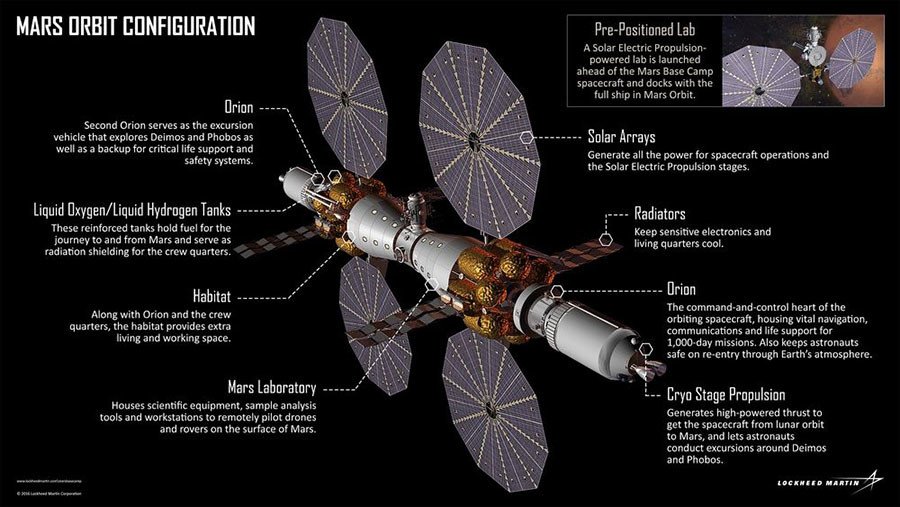Lockheed Martian? Deep space habitat spacecraft envisioned to orbit Mars in 12 years

Lockheed Martin thinks NASA needs a “Mars Base Camp,” or deep space habitat spacecraft, for humans landing on Mars by the 2030s or ’40s. The spacecraft would orbit the red planet and house a laboratory to be staffed by six astronauts.
“We think that orbiting Mars is a necessary precursor to landing humans on the surface,” Tony Antonelli, Lockheed Martin’s chief technologist for civil space exploration and a former NASA astronaut, told Popular Science. “NASA has that in their plans, and we’re coloring in the details.”
The six astronauts would live in Mars’ orbit and pilot rovers and UAVs. Lockheed Martin, a leading US military contractor, was due to introduce its spacecraft concept on Wednesday during a presentation at the Humans to Mars summit taking place in Washington, DC.

The Mars Base Camp relies on near-term technology, either already proven or in development.
“All of these pieces exist today, they’re not brand new,” says Antonelli, a former astronaut who piloted two shuttle missions to the International Space Station in 2009 and 2010. “We’re taking advantage of what we’ve already got.”
NASA is currently commissioning Boeing to build a Space Launch System (SLS) rocket and working with Lockheed on creating the Orion crew capsule. The rocket’s design review was completed in 2014, and flight qualification parts are being fabricated. The Orion crew capsule will move into its flight test phase over the next few years, with an un-crewed mission planned for 2018. It is scheduled to carry astronauts into deep space in 2023.
Building rockets and spaceships. Check out @exploremars webcast: https://t.co/qa4ea6vJND#JourneyToMars#space#NASApic.twitter.com/GvldyWxX3C
— Boeing Defense (@BoeingDefense) May 18, 2016
According to the plan, Orion will serve as the Mars Base Camp’s engine by providing navigation and communications. It could also link up with habitat model, which could use solar panels to provide power. The spacecraft could be launched on the SLS rocket and assembled in space around the moon.
Congressional spending bill boosts NASA budget beyond White House requesthttps://t.co/ICAEXJYz3tpic.twitter.com/VV7HoWquWE
— RT America (@RT_America) December 17, 2015
Lockheed says NASA could maintain astronauts in Martian orbit for as long as about 10 or 11 months with the help of the Mars Base Camp.
Astronauts in the Base Camp could direct flying robots to safe landing places, from which they could explore the red planet.
“We think that putting scientists with laboratories right there in Mars orbit will allow them, in just a few months, to accomplish more science than we’ve been able to accomplish in the past 40 years,” Antonelli said.
NASA-backed program aims to prolong life of machines by studying their ‘DNA’https://t.co/YTUFOfciwjpic.twitter.com/hAHMHPTVOl
— RT America (@RT_America) May 16, 2016
It currently takes 20 minutes for a signal to travel between Earth and Mars. Scientists driving rovers on Mars are doing so somewhat blind, without immediate visual feedback, but operating from a base camp could change all that, allowing Mars to be explored in a whole new way.












